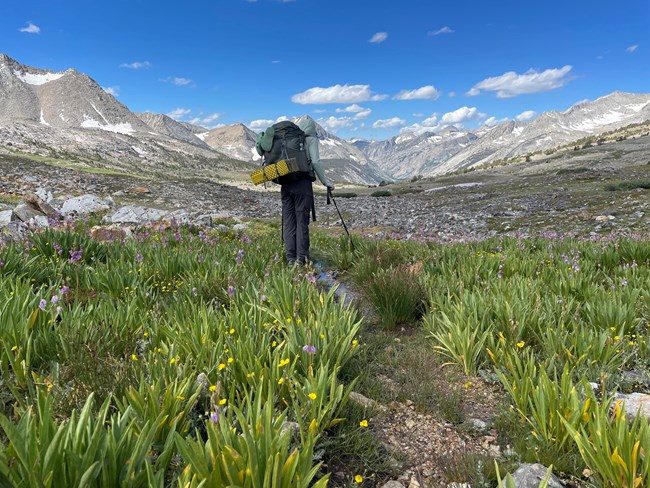
Photo by: Alex Brown, Great Basin Institute
Applying for Seasonal Field Positions or Other Temporary Positions
How do you apply for field positions with us? The Sierra Nevada Network (SIEN) hires or works with partner organizations to hire seasonal staff to collect field data for our birds, high-elevation forests, lakes, and wetlands monitoring projects in Sequoia & Kings Canyon National Parks, Yosemite National Park, and Devils Postpile National Monument. All of our field staff backpack to remote backcountry sites to collect monitoring data. To learn more about our program, visit our monitoring projects web page. Learn more about our field season opportunities through each of the organizations described below.
Summer 2025 Jobs
Job announcements to work as a field crew member with the Sierra Nevada Network (SIEN) monitoring program are now open and receiving applications!We are hiring for aquatic (lakes and wetlands) and forest monitoring crews that will work across Sequoia, Kings Canyon, and Yosemite national parks, and Devils Postpile National Monument. Announcement links:
SIEN Bio Tech Positions (Aquatic)
SIEN Bio Tech Positions (Plants)
Lake and Wetland Crews:
SIEN is hiring field crews to collect monitoring data at mountain lakes and wetlands across SIEN parks. Duties include backpacking to remote mountain lakes and wetlands, collecting and processing water samples, surveying for amphibians, maintaining groundwater monitoring wells and dataloggers, and managing and entering field data into databases.
Position Information: Biological Science Technician (Aquatic Ecosystems) GS-5/6 based with SIEN and duty stationed at Sequoia or Yosemite national parks. Apply through USAJobs - Open from Dec 4 until the applicant cap is reached or until Dec. 13, whichever comes first. We strongly recommend you apply early to ensure being considered for the position. Link to announcement: SIEN Bio Tech Positions (Aquatic)
Forest Mortality Crew:
SIEN is hiring a team of field biologists to assess the health of subalpine forests. Our forest mortality crew will gather information on whitebark and foxtail pine mortality in remote wilderness areas of the Sierra Nevada. Duties include forest ecology and field data collection, electronic data collection, data entry, and database management, backpacking, off-trail navigation and camping while conducting fieldwork, teamwork, and being a member of a field crew.
Position Information: Biological Science Technician (Plants) GS-5/6/7 that will be based out of the eastern Sierra Nevada. Apply through USAJobs - Open from Dec 4 until the applicant cap is reached or until Dec. 13, whichever comes first. We strongly recommend you apply early to ensure being considered for the position. Link to announcement: SIEN Bio Tech Positions (Plants)
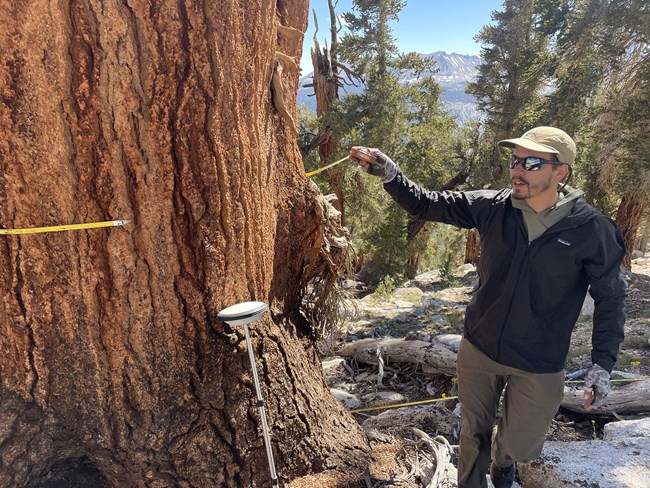
Photo by Zoe Klein, Great Basin Institute
National Park Service
Each season we hire some of our field positions through the National Park Service. Applicants can find position announcements and apply for jobs through the USAJobs website. To apply for National Park Service positions, you must create a USAJobs profile. Be sure to provide enough detail in your resume to fully document the Knowledge, Skills, and Abilities ratings that you give yourself. For tips on creating a federal resume, watch this 5-minute video, or check out these tips.
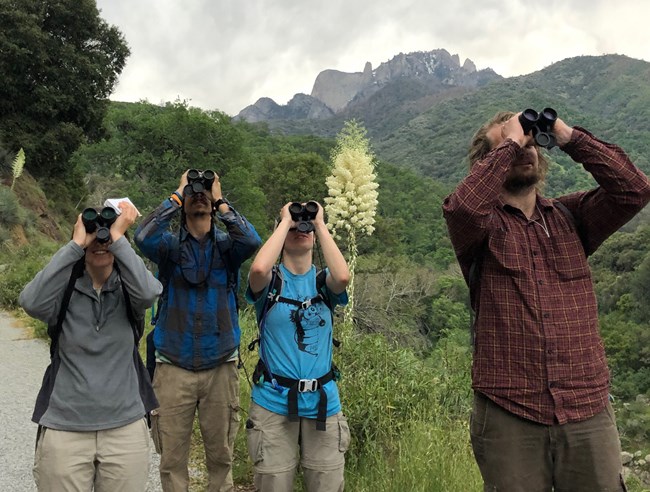
Photo courtesy of Bob Wilkerson, The Institute for Bird Populations
The Institute for Bird Populations
The Institute for Bird Populations (IBP) partners with government agencies, universities, and non-government organizations to support science-based conservation of species by studying the abundance, demography, and ecology of birds and other wildlife. IBP works closely with our network to monitor birds. They recruit, hire, and supervise field crew members and help with field season planning. Local NPS staff partner with IBP in project training, oversight, and field season logistics. Our bird crews work in two crews of two people each, and these crews hike into the backcountry for up to seven days at a time to conduct bird point counts. The season begins with an intensive three-week training session in visual and acoustic bird identification, point count techniques, orienteering and safety, and wilderness camping skills. Crew members acquire substantial expertise in western bird identification, general natural history, and backcountry living.
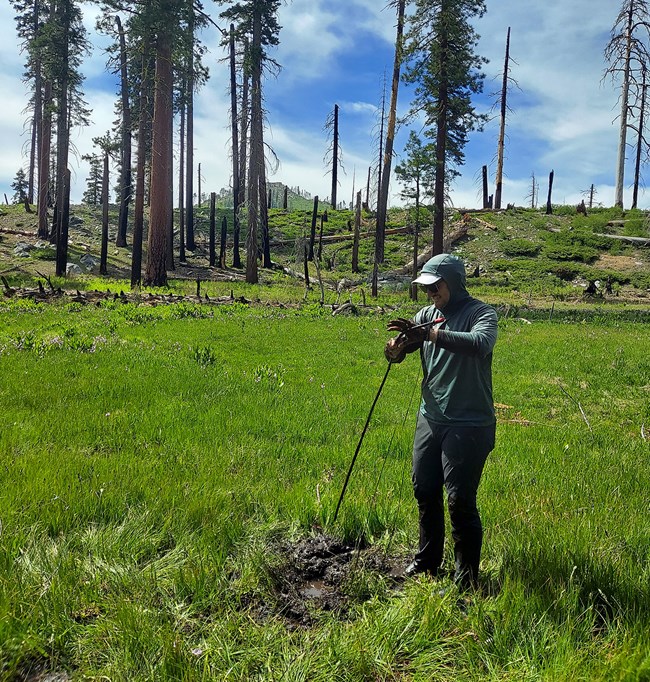
Photo by Kelly Bessem, Lake Monitoring Crew Lead, Great Basin Institute
Great Basin Institute
The Great Basin Institute (GBI) promotes environmental research, education and service through agency partnerships, such as those with the National Park Service and other federal agencies. When hired for a position through the Great Basin Institute, the field staff member is formally supervised and paid through GBI, but local staff also provide training and guidance.
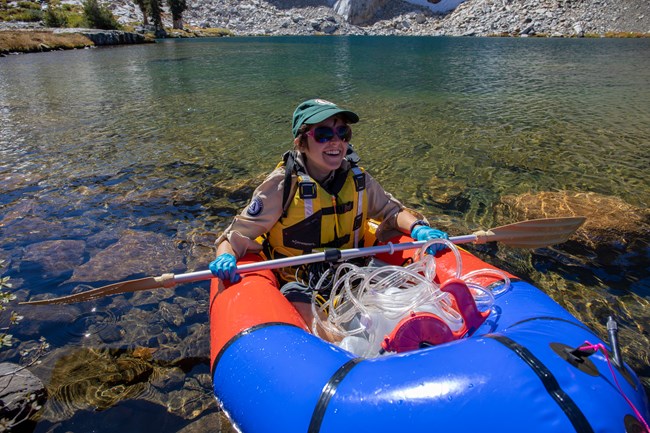
NPS Photo by Glauco Puig-Santana
Scientists in Parks Internships
The Scientists in Parks (SIP) program offers internships to work on a variety of natural resource projects in national parks. Learn more about the benefits and eligibility requirements of the SIP program. It is also important to carefully read all eligibility requirements as stated in the individual position announcements.
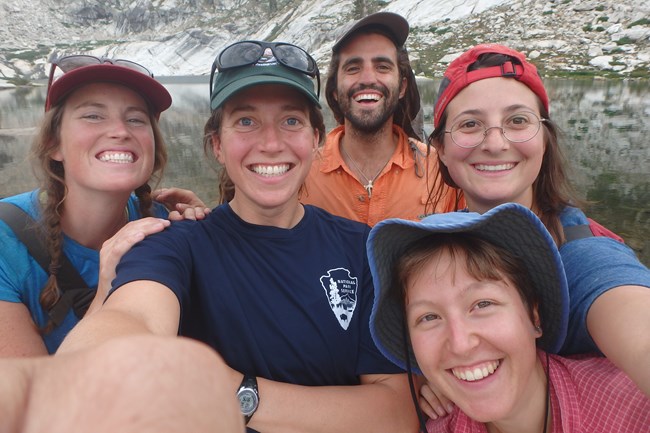
Photo by Marisa Monroe, Geoscientist-in-Parks intern, 2018.
What is it like to work on our field crews?
Visit the following web pages and watch the videos to learn more about our lakes and forest monitoring projects from field crew members, our project leads, and park managers:
Click on the names below to hear from three field staff who went on to graduate school. These short articles highlight what they enjoyed about their work here and how it inspired them to pursue their own research projects as graduate students.
Last updated: February 6, 2025
